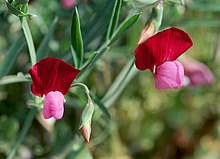This article may need to be rewritten to comply with Wikipedia's quality standards. (April 2018) |
| Lathyrus clymenum | |
|---|---|

| |
| Scientific classification | |
| Kingdom: | Plantae |
| Clade: | Tracheophytes |
| Clade: | Angiosperms |
| Clade: | Eudicots |
| Clade: | Rosids |
| Order: | Fabales |
| Family: | Fabaceae |
| Subfamily: | Faboideae |
| Genus: | Lathyrus |
| Species: | L. clymenum
|
| Binomial name | |
| Lathyrus clymenum | |
| Synonyms[1] | |
| |

Lathyrus clymenum, also called Spanish vetchling,[2] is a flowering plant in the family Fabaceae, native to the Mediterranean. The seeds are used to prepare a Greek dish called fava santorinis. The plant is cultivated on the island of Santorini in Greece and was recently added to the European Union's products with a Protected Designation of Origin.
For 3,500 years residents of Santorini and neighbouring islands have been cultivating the legume species Lathyrus clymenum, known elsewhere only as a wild plant.[3] The peculiar ecosystem that was created by the volcanic explosions on Santorini island, the volcanic ash, the cellular soil, and the combination of humidity created by the sea and the drought, make the bean a unique resource. When weather conditions are good, farmers on the island can reap about 800 kilograms of beans per hectare. A vulnerable crop, it can be destroyed by strong winds that blow away its flowers before they can yield the pea, by drought or by a sudden heat wave almost instantly. Its production is thus limited, making it an expensive crop that costs €700 per acre. The cost for consumers is about €9–10 per kilogram.[citation needed]
- ^ "The Plant List: A Working List of All Plant Species". Retrieved 7 March 2015.
- ^ "Lathyrus clymenum". Germplasm Resources Information Network. Agricultural Research Service, United States Department of Agriculture. Retrieved 7 March 2015.
- ^ Anaya Sarpaki, Glynis Jones, "Ancient and Modern Cultivation of Lathyrus clymenum L. in the Greek Islands" in Annual of the British School at Athens vol. 85 (1990) pp. 363–368 JSTOR